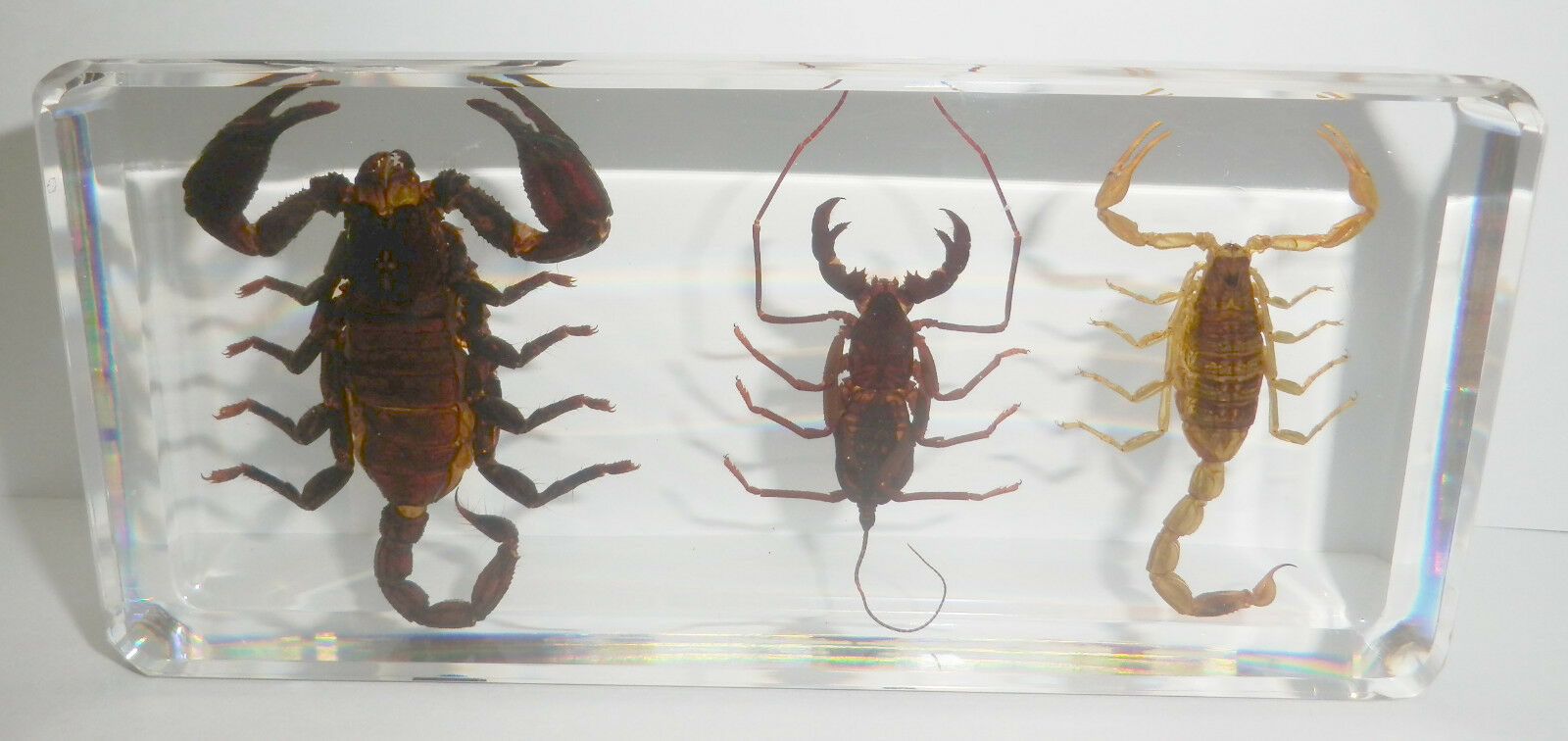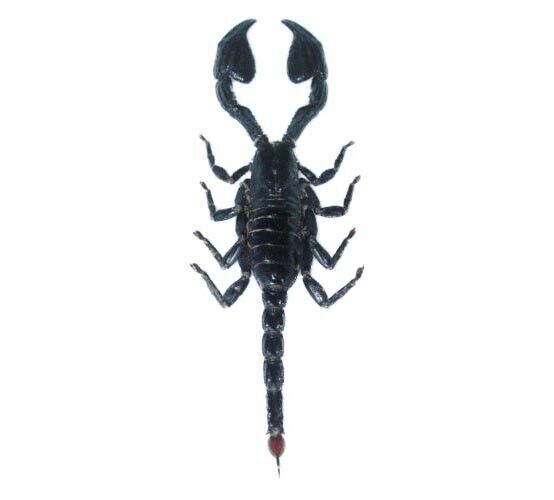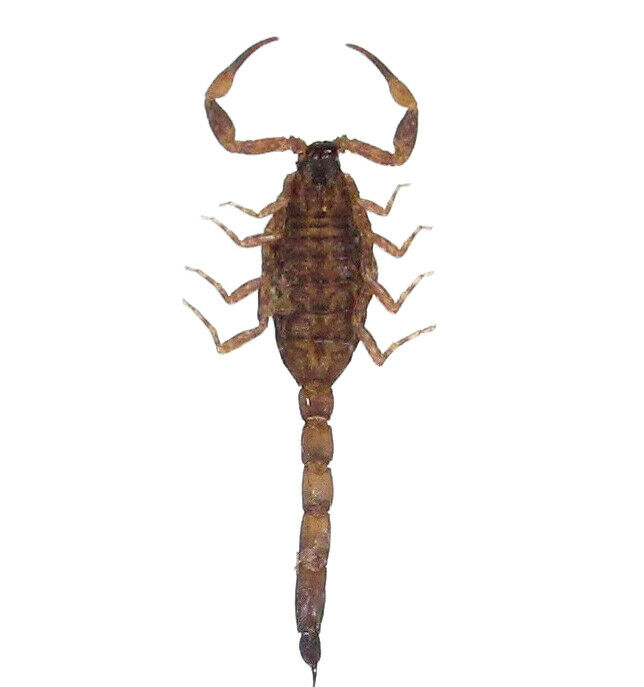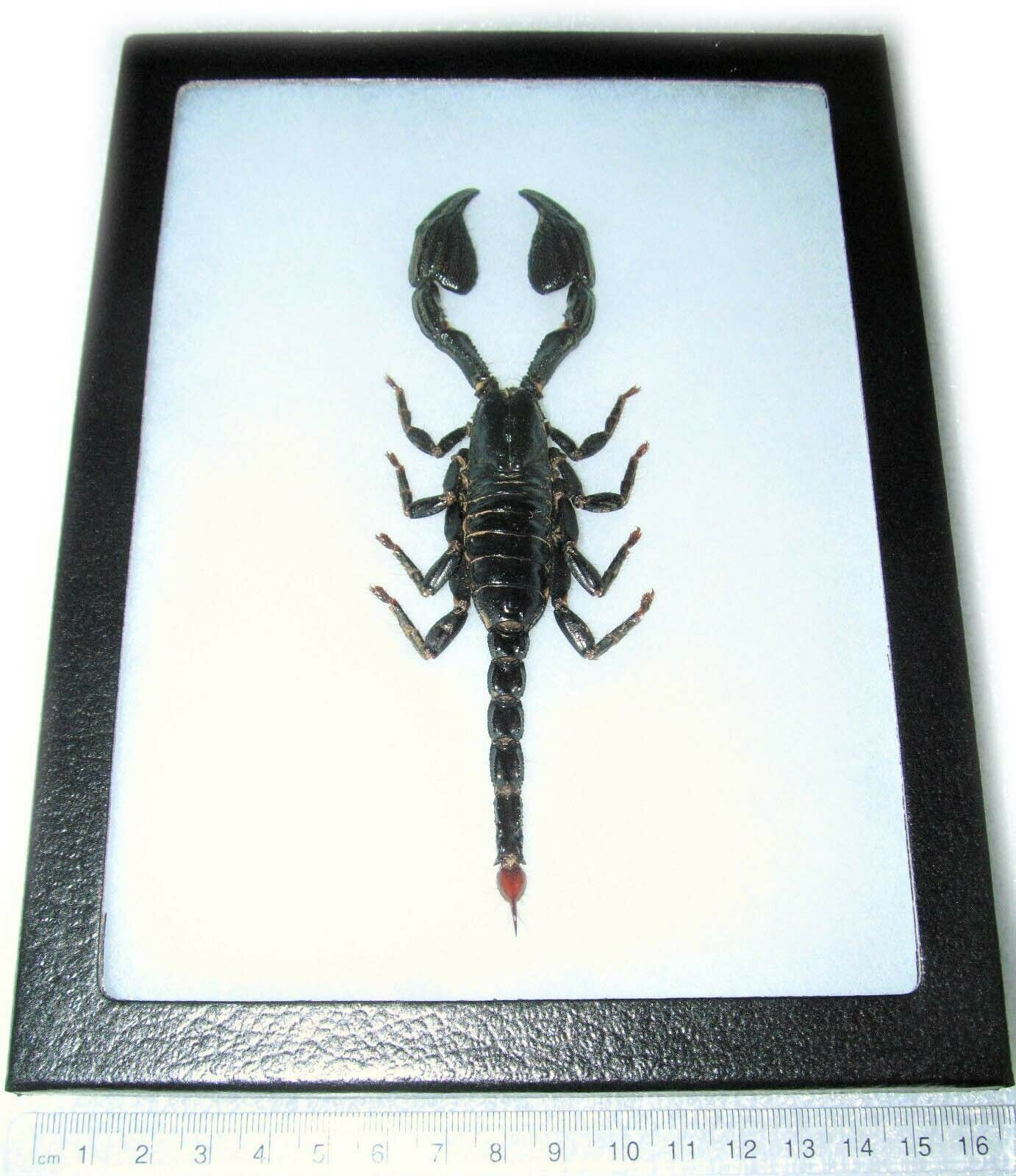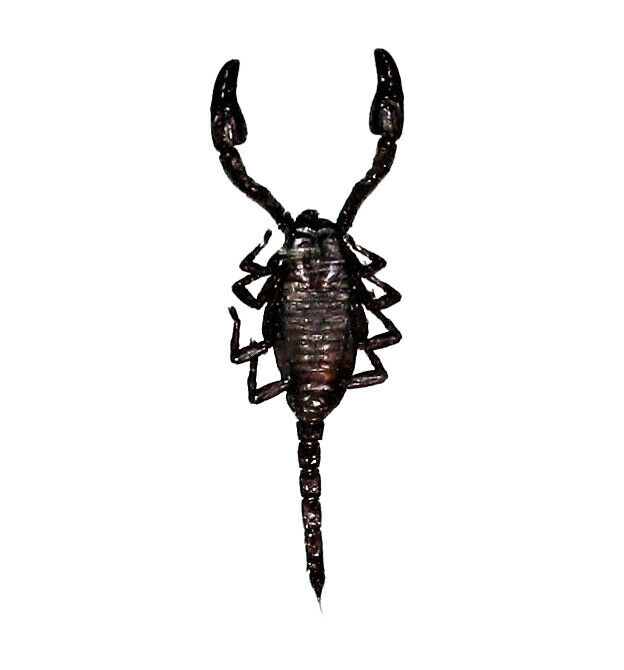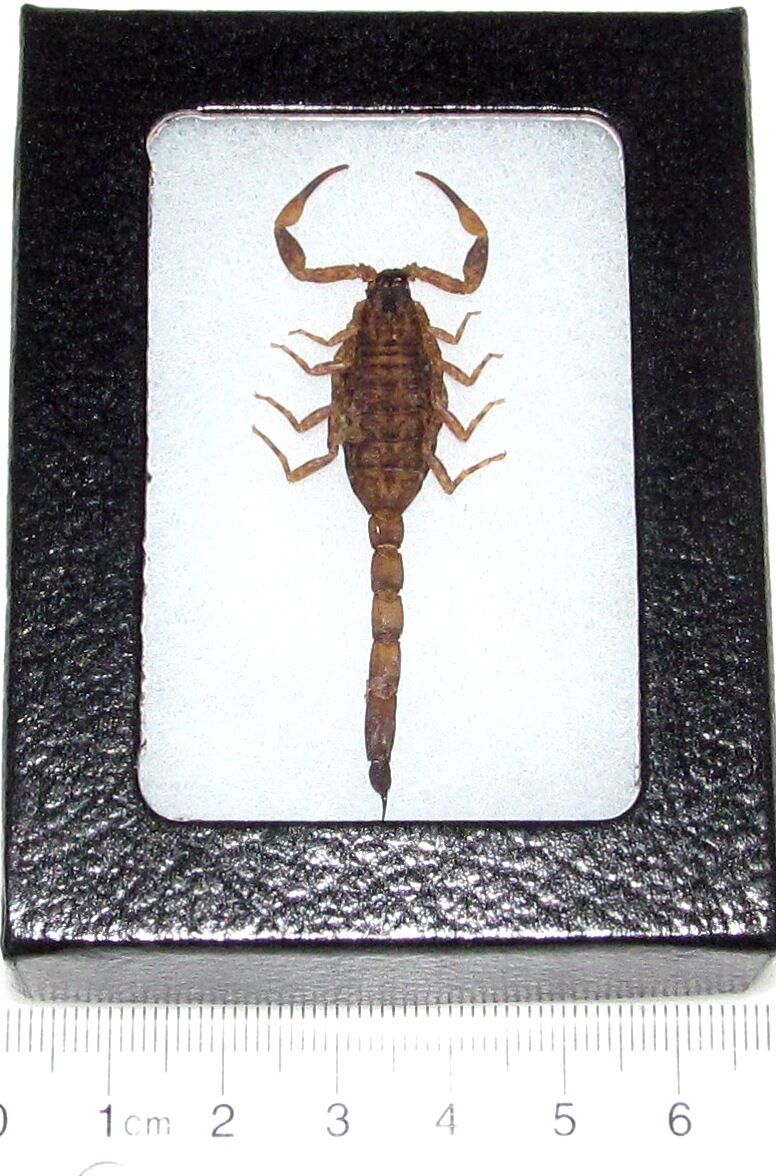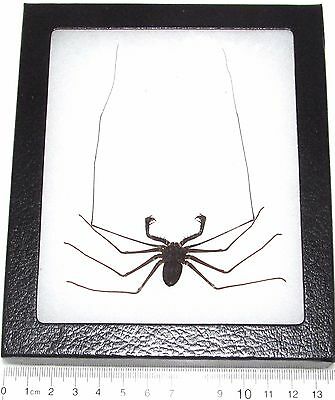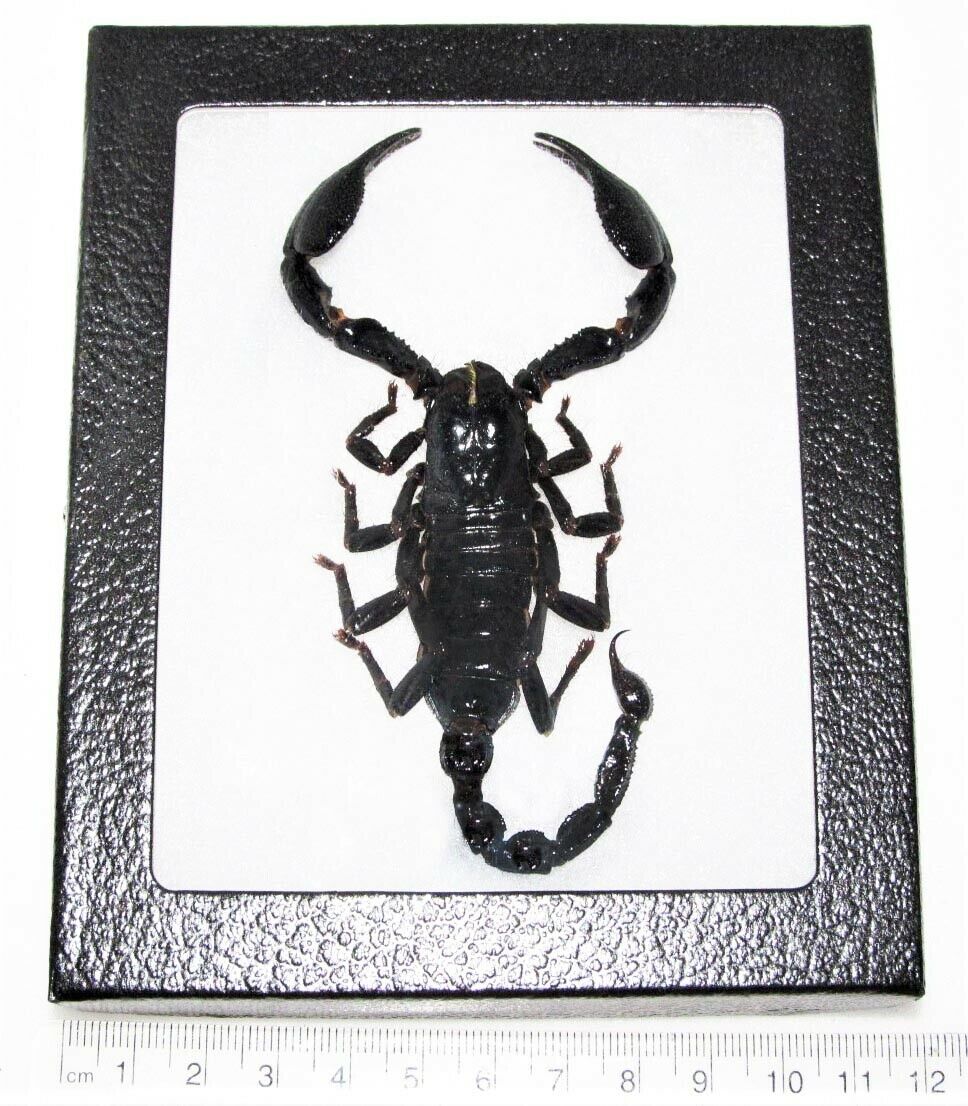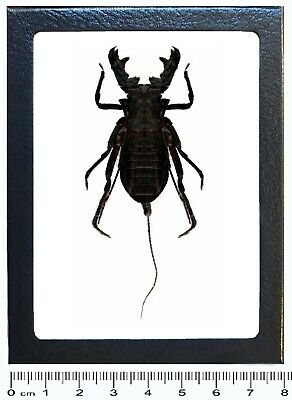-40%
3 Scorpion Set Golden + Whip + Black Scorpion Specimen Learning Kit KCD10
$ 14.77
- Description
- Size Guide
Description
Insect Collection Set - 3 ScorpionsA set of 3 real Scorpions (Chinese Golden Scorpion - Mesobuthus martensii, Whip Scorpion - Typopeltis crucifer and Asian Forest Black Scorpion - Heterometrus spinifer) specimen encased in rectangular indestructible, transparent lucite block. Safe, authentic and completely unbreakable product put real Scorpions right at your fingertips!
Anyone can safely explore the Scorpions from every angle.
It is clear enough for microscope observation.
Length of the Scorpions from head to bottom are: 4.3 cm (1.7 inch), 3.2 cm (1.3 inch) and 4.3 cm(1.7 inch).
Allaboutlearning
Your best online business partner
3 Scorpion Set Golden + Whip + Black Scorpion Specimen Learning Kit KCD10
Insect Collection Set - 3 Scorpions
A set of 3 real Scorpions
(
Chinese Golden Scorpion
- Mesobuthus martensii
, Whip Scorpion -
Typopeltis crucifer
and
Asian Forest Black Scorpion -
Heterometrus spinifer
)
specimen encased in rectangular indestructible, transparent lucite block. Safe, authentic and completely unbreakable product put real Scorpions right at your fingertips!
Anyone can safely explore the Scorpions from every angle.
It is clear enough for microscope observation.
Length of the Scorpions from head to bottom are: 4.3 cm (1.7 inch), 3.2 cm (1.3 inch) and 4.3 cm(1.7 inch).
Size of the lucite block is 140x63x20 mm(5.5x2.5x0.8 inch).
Weight of the block is 200 g and 230 g with packing box.
This is a handmade real animal specimen craft. Each one will be a bit different (specimen size, color and posture) even in the same production batch.
The pictures in the listing are just for reference as we are selling multiple pieces with same pictures.
***
Chinese Golden Scorpion -
Mesobuthus martensii
Mesobuthus martensii
is a species of scorpion in the family Buthidae. Its common names include
Chinese scorpion
,
Manchurian scorpion
,
Chinese armor-tail scorpion
and
Chinese golden scorpion
. Despite its common name, this scorpion is not only found in Manchuria or China, but also in Mongolia, Korea and Japan. Its preferred habitat is warm, dry areas with little vegetation.
M. martensii
can grow to about 6 centimetres (2.4 in) long, with females usually slightly larger, and has a life-span of about 4 to 6 years.
M. martensii
, especially its tail, has been used in traditional Chinese medicine for many centuries to treat various neuronal problems, such as chronic pain, paralysis, apoplexy and epilepsy. Over the past few decades, dozens of novel proteins in this scorpion's venom have been identified, cloned and investigated for clinical applications. For instance, at least 51 long-chain peptides related to the sodium channel toxins and 18 peptides related to the potassium channel toxins have been described, along with two peptides,
Bm
K AS and AS1, that act on ryanodine receptors. Apart from having analgesic properties,
Bm
K AS is also the first long-chain scorpion peptide reported to have antimicrobial activity. Amongst the sodium channel-specific neurotoxins, there are a number of muscle relaxants, such as makatoxin I and bukatoxin, while
Bm
KAEP and
Bm
K IT2 have shown anticonvulsant activity in experimental conditions, inhibiting epileptic seizures induced in rats.
Bm
K AGAP has both analgesic and antitumor properties and recombinant proteins could potentially be used in anticancer treatments.
Whip Scorpion -
Typopeltis crucifer
This species can be found in China, Taiwan, Japan and Korea
Order:
Thelyphonida
Diversity c. 15 genera, > 100 species
Families Geralinuridae, Thelyphonidae
A
uropygid
, commonly known as a
whip scorpion
, is an invertebrate animal belonging to the former order "Uropygi" in the class Arachnida, in the subphylum Chelicerata of the phylum Arthropoda. They are also known as the
vinegarone
or
vinegaroon
because when agitated they can spray a secretion of acetic acid.
The name "uropygid" means "tail rump", referring to the whip-like flagellum on the end of the pygidium, a small plate made up of the last three segments of the abdominal exoskeleton.
Whip scorpions range from 25 to 85 mm in length, with most species not longer than 30 mm; the largest species, of the genus
Mastigoproctus
, reaching 85 mm.
Like the related orders
Schizomida
,
Amblypygi
, and
Solifugae
, the uropygids use only six legs for walking, having modified their first two legs to serve as antennae-like sensory organs. Many species also have very large scorpion-like pedipalps (pincers). They have one pair of eyes at the front of the cephalothorax and three on each side of the head, a pattern also found in scorpions Whip scorpions have no poison glands, but they do have glands near the rear of their abdomen that can spray a combination of acetic acid and octanoic acid when they are bothered. The acetic acid gives this spray a vinegar-like smell, giving rise to the common name
vinegaroon
. Other species spray formic acid or chlorine.
Whip scorpions are carnivorous, nocturnal hunters feeding mostly on insects and millipedes, but sometimes on worms and slugs.
Mastigoproctus
sometimes preys on small vertebrates. The prey is crushed between special teeth on the inside of the trochanters (the second segment of the leg) of the front legs. They are valuable in controlling the population of roaches and crickets.
Males secrete a sperm sac, which is transferred to the female. Up to 35 eggs are laid in a burrow, within a mucous membrane that preserves moisture. Mothers stay with the eggs and do not eat. The white young that hatch from the eggs climb onto their mother's back and attach themselves there with special suckers. After the first molt they look like miniature whip scorpions, and leave the burrow; the mother dies soon after. The young grow slowly, going through three molts in about three years before reaching adulthood. They live for up to another four years.
Uropygids are found in tropical and subtropical areas worldwide. They are missing in Europe, Australia, and, except for an introduced species, in Africa. They usually dig underground burrows with their pedipalps, to which they transport their prey. They may also burrow under logs, rotting wood, rocks, and other natural debris. They enjoy humid, dark places and avoid the light.
The whip scorpions have a life pattern similar to the true scorpions, but they do not possess a poisonous sting. Their flat body enables them to squeeze into extremely narrow cracks and crevices, where they prey on small arthropods and worms. A few of the larger species also attack small vertebrates, especially frogs. The palps are developed into strong pincers equipped with sharp teeth and spines, which are used for catching and crushing prey. The first pair of legs are generally much longer and thinner than the other three pairs, and may have more a tactile function rather than walking.
The Vinegarroon (also spelled Vinegaroon,
Mastigoproctus giganteus
) is a large whip-scorpion of Mexico and southern United States that emits a vinegar-like mist (containing mostly acetic acid) when alarmed.
The Vinegarroon is not venomous and is not a true scorpion. It is related to spiders, true scorpions, and ticks. Classification: Class Arachnida (arachnids) , Order Uropygi (containing about 100 species of Whip Scorpions).
Vinegarroons are invertebrates that are found in the southern USA and in Mexico. Other Whip Scorpions are found in India, Japan, and New Guinea.
Diet
: Vinegarroons are
carnivores
(meat-eaters) that hunt at night (they are nocturnal). They use their powerful pincers to catch prey. During the day, Vinegarroons hide under leaves or rocks.
Anatomy
: Whip Scorpions have four pairs of legs and a hard, protective exoskeleton. There are two organs near the base of the tail that produce a vinegar-like mist which the Whip Scorpion emits when it is irritated. The long, whip-like tail is used as a sensory organ and does not have a stinger (unlike true scorpions, which have a stinger at the tip of the segmented tail).
Black Scorpion (Asian Forest Scorpion)
Heterometrus spinifer
Origin: Malaysia, Thailand, Cambodia, Vietnam
Biotype: Tropical
Adult Size: up to 16 cm
Expectance of life: 8 cm
Food: insects (crickets, cockroaches, crickets), the scorpion may beforehand eat anything that moves, but the insects are adequate.
Description: This is a magnificent scorpion, which at adult size, can reach the size of 15cm, with a large body and imposing less than Pandinus Imperator. It is black with blue highlights, with large claws (leaner than those of P. Imperator). This species can be manipulated because it is calm and sociable, however, we must not lose sight of the fact that the bite is it can inflict very painful fever, vomiting and eye problems can occur passengers!
The scorpions need a normal cycle day / night, but they are crepuscular and often more active at night, when everything is calm and they can come out of hiding. The gestation length of the female is approximately 1 year, with 30-35 kids who may remain several months on the back of the mother. They are mature to 12-15 months.
The Heterometrus Spinifer Scorpions are common to most parts of SE Asia and Southern China.
Scorpions are a diverse group of arachnids and include 16 families, 159 genera with 1260 described species worldwide. The Heterometrus Spinifer is common to Thailand and China is one of a few species that is known to be edible. Scorpions are ancient animals and fossil records indicate that they were already in existence about 425 – 450 million years ago during the Silurian period and evolved from an amphibious ancestor. They occur in habitats ranging from forest to deserts but it is in the arid areas that they are most common and diverse.
Item Specifics
Country/Region of Manufacture
China
Material
Resin
Type
Collector Plate
Modified Item
No
Payment
Payment: By Paypal
Shipping cost
Free shipping cost.
We send the goods to USA, Canada, UK, Australia, New Zealand, EU countries and some other European and Asian countries by E-express, a kind of fast postal service by Hong Kong Post. It usually takes about 6 to 10 working days for delivery.
We send the goods to other countries by registered airmail and will take about 8 to 14 working days for delivery.
Return policy
Returns: We accept returns with any reason in 30 days. Buyer will bear the return shipping cost.
Messages
We will answer messages in 24 hours during working days.
[ Policy
: This is the contents of your policies. You can add a banner for this policy as header and add text descriptions here. The text descriptions can be different Font Size, Font Color, Style and even graphics and icons are also accepted. ]
Allaboutlearning
Your best online business partner
3 Scorpion Set Golden + Whip + Black Scorpion Specimen Learning Kit KCD10
Insect Collection Set - 3 Scorpions
A set of 3 real Scorpions
(
Chinese Golden Scorpion
- Mesobuthus martensii
, Whip Scorpion -
Typopeltis crucifer
and
Asian Forest Black Scorpion -
Heterometrus spinifer
)
specimen encased in rectangular indestructible, transparent lucite block. Safe, authentic and completely unbreakable product put real Scorpions right at your fingertips!
Anyone can safely explore the Scorpions from every angle.
It is clear enough for microscope observation.
Length of the Scorpions from head to bottom are: 4.3 cm (1.7 inch), 3.2 cm (1.3 inch) and 4.3 cm(1.7 inch).
Size of the lucite block is 140x63x20 mm(5.5x2.5x0.8 inch).
Weight of the block is 200 g and 230 g with packing box.
This is a handmade real animal specimen craft. Each one will be a bit different (specimen size, color and posture) even in the same production batch.
The pictures in the listing are just for reference as we are selling multiple pieces with same pictures.
***
Chinese Golden Scorpion -
Mesobuthus martensii
Mesobuthus martensii
is a species of scorpion in the family Buthidae. Its common names include
Chinese scorpion
,
Manchurian scorpion
,
Chinese armor-tail scorpion
and
Chinese golden scorpion
. Despite its common name, this scorpion is not only found in Manchuria or China, but also in Mongolia, Korea and Japan. Its preferred habitat is warm, dry areas with little vegetation.
M. martensii
can grow to about 6 centimetres (2.4 in) long, with females usually slightly larger, and has a life-span of about 4 to 6 years.
M. martensii
, especially its tail, has been used in traditional Chinese medicine for many centuries to treat various neuronal problems, such as chronic pain, paralysis, apoplexy and epilepsy. Over the past few decades, dozens of novel proteins in this scorpion's venom have been identified, cloned and investigated for clinical applications. For instance, at least 51 long-chain peptides related to the sodium channel toxins and 18 peptides related to the potassium channel toxins have been described, along with two peptides,
Bm
K AS and AS1, that act on ryanodine receptors. Apart from having analgesic properties,
Bm
K AS is also the first long-chain scorpion peptide reported to have antimicrobial activity. Amongst the sodium channel-specific neurotoxins, there are a number of muscle relaxants, such as makatoxin I and bukatoxin, while
Bm
KAEP and
Bm
K IT2 have shown anticonvulsant activity in experimental conditions, inhibiting epileptic seizures induced in rats.
Bm
K AGAP has both analgesic and antitumor properties and recombinant proteins could potentially be used in anticancer treatments.
Whip Scorpion -
Typopeltis crucifer
This species can be found in China, Taiwan, Japan and Korea
Order:
Thelyphonida
Diversity c. 15 genera, > 100 species
Families Geralinuridae, Thelyphonidae
A
uropygid
, commonly known as a
whip scorpion
, is an invertebrate animal belonging to the former order "Uropygi" in the class Arachnida, in the subphylum Chelicerata of the phylum Arthropoda. They are also known as the
vinegarone
or
vinegaroon
because when agitated they can spray a secretion of acetic acid.
The name "uropygid" means "tail rump", referring to the whip-like flagellum on the end of the pygidium, a small plate made up of the last three segments of the abdominal exoskeleton.
Whip scorpions range from 25 to 85 mm in length, with most species not longer than 30 mm; the largest species, of the genus
Mastigoproctus
, reaching 85 mm.
Like the related orders
Schizomida
,
Amblypygi
, and
Solifugae
, the uropygids use only six legs for walking, having modified their first two legs to serve as antennae-like sensory organs. Many species also have very large scorpion-like pedipalps (pincers). They have one pair of eyes at the front of the cephalothorax and three on each side of the head, a pattern also found in scorpions Whip scorpions have no poison glands, but they do have glands near the rear of their abdomen that can spray a combination of acetic acid and octanoic acid when they are bothered. The acetic acid gives this spray a vinegar-like smell, giving rise to the common name
vinegaroon
. Other species spray formic acid or chlorine.
Whip scorpions are carnivorous, nocturnal hunters feeding mostly on insects and millipedes, but sometimes on worms and slugs.
Mastigoproctus
sometimes preys on small vertebrates. The prey is crushed between special teeth on the inside of the trochanters (the second segment of the leg) of the front legs. They are valuable in controlling the population of roaches and crickets.
Males secrete a sperm sac, which is transferred to the female. Up to 35 eggs are laid in a burrow, within a mucous membrane that preserves moisture. Mothers stay with the eggs and do not eat. The white young that hatch from the eggs climb onto their mother's back and attach themselves there with special suckers. After the first molt they look like miniature whip scorpions, and leave the burrow; the mother dies soon after. The young grow slowly, going through three molts in about three years before reaching adulthood. They live for up to another four years.
Uropygids are found in tropical and subtropical areas worldwide. They are missing in Europe, Australia, and, except for an introduced species, in Africa. They usually dig underground burrows with their pedipalps, to which they transport their prey. They may also burrow under logs, rotting wood, rocks, and other natural debris. They enjoy humid, dark places and avoid the light.
The whip scorpions have a life pattern similar to the true scorpions, but they do not possess a poisonous sting. Their flat body enables them to squeeze into extremely narrow cracks and crevices, where they prey on small arthropods and worms. A few of the larger species also attack small vertebrates, especially frogs. The palps are developed into strong pincers equipped with sharp teeth and spines, which are used for catching and crushing prey. The first pair of legs are generally much longer and thinner than the other three pairs, and may have more a tactile function rather than walking.
The Vinegarroon (also spelled Vinegaroon,
Mastigoproctus giganteus
) is a large whip-scorpion of Mexico and southern United States that emits a vinegar-like mist (containing mostly acetic acid) when alarmed.
The Vinegarroon is not venomous and is not a true scorpion. It is related to spiders, true scorpions, and ticks. Classification: Class Arachnida (arachnids) , Order Uropygi (containing about 100 species of Whip Scorpions).
Vinegarroons are invertebrates that are found in the southern USA and in Mexico. Other Whip Scorpions are found in India, Japan, and New Guinea.
Diet
: Vinegarroons are
carnivores
(meat-eaters) that hunt at night (they are nocturnal). They use their powerful pincers to catch prey. During the day, Vinegarroons hide under leaves or rocks.
Anatomy
: Whip Scorpions have four pairs of legs and a hard, protective exoskeleton. There are two organs near the base of the tail that produce a vinegar-like mist which the Whip Scorpion emits when it is irritated. The long, whip-like tail is used as a sensory organ and does not have a stinger (unlike true scorpions, which have a stinger at the tip of the segmented tail).
Black Scorpion (Asian Forest Scorpion)
Heterometrus spinifer
Origin: Malaysia, Thailand, Cambodia, Vietnam
Biotype: Tropical
Adult Size: up to 16 cm
Expectance of life: 8 cm
Food: insects (crickets, cockroaches, crickets), the scorpion may beforehand eat anything that moves, but the insects are adequate.
Description: This is a magnificent scorpion, which at adult size, can reach the size of 15cm, with a large body and imposing less than Pandinus Imperator. It is black with blue highlights, with large claws (leaner than those of P. Imperator). This species can be manipulated because it is calm and sociable, however, we must not lose sight of the fact that the bite is it can inflict very painful fever, vomiting and eye problems can occur passengers!
The scorpions need a normal cycle day / night, but they are crepuscular and often more active at night, when everything is calm and they can come out of hiding. The gestation length of the female is approximately 1 year, with 30-35 kids who may remain several months on the back of the mother. They are mature to 12-15 months.
The Heterometrus Spinifer Scorpions are common to most parts of SE Asia and Southern China.
Scorpions are a diverse group of arachnids and include 16 families, 159 genera with 1260 described species worldwide. The Heterometrus Spinifer is common to Thailand and China is one of a few species that is known to be edible. Scorpions are ancient animals and fossil records indicate that they were already in existence about 425 – 450 million years ago during the Silurian period and evolved from an amphibious ancestor. They occur in habitats ranging from forest to deserts but it is in the arid areas that they are most common and diverse.
Item Specifics
Country/Region of Manufacture :
China
Material :
Resin
Type :
Collector Plate
Modified Item :
No
Payment
Payment: By Paypal
Shipping cost
Free shipping cost.
We send the goods to USA, Canada, UK, Australia, New Zealand, EU countries and some other European and Asian countries by E-express, a kind of fast postal service by Hong Kong Post. It usually takes about 6 to 10 working days for delivery.
We send the goods to other countries by registered airmail and will take about 8 to 14 working days for delivery.
Return policy
Returns: We accept returns with any reason in 30 days. Buyer will bear the return shipping cost.
Messages
We will answer messages in 24 hours during working days.
[ Policy
: This is the contents of your policies. You can add a banner for this policy as header and add text descriptions here. The text descriptions can be different Font Size, Font Color, Style and even graphics and icons are also accepted. ]
Copyright of XXXXX. All right reserved.
Shop Category
Store Home
Minerals, Stones & Gemstones
◈ Display Specimens Set
◈ Stone Mix & Bulk Lots
◈ Single piece
Animal and plant specimens
◈ Collection Sets
◈ Life Cycle Specimen
◈ Animal Skeleton
◈ Laminated Specimen
◈ Insect single specimen
◈ Animal single specimen
◈ Plant Single Specimen
Animal & plant ornament
◈ Key ring
◈ Bracelet
◈ Necklace
◈ Hanger
◈ Cabochon
◈ Magnet
◈ Dome paperweight
Meteorite & Tektite
◈ Black Tektite - Single piece
◈ Black Tektite - Loose Lot
◈ Black Tektite - Crafts
Star Ruby & Sapphire
▷ Star Ruby
♢ Opaque Star Ruby
◈ Star Sapphire
Turquoise items
◈ Natural - cabochon
Other
Hot Item
Insect Cabochon Golden Scorpion Oval 18x25 mm on black bottom 2 pieces Lot
USD 12.00
Murder Hornet - 7 Seven Bee Wasp & Hornet Collection Set Education Specimen
USD 35.00
Insect Cabochon Golden Scorpion Oval 18x25 mm on white bottom 2 pieces Lot
USD 12.00
Insect Cabochon Golden Scorpion 38.5 mm Round inner 35 mm on Black 2 pieces Lot
USD 12.00
Black Indochinite Tektite Stone 15 to 50 gram Size Pieces 80 gram Lot
USD 15.00
Picture
New List Item
Amazonite Large Rough Stone from Brazil 412.1 gram 78x78x51 mm
USD 21.99
Tumbled Tiger Eye Stone Specimen 58.4 gram 33x30x26 mm
USD 11.99
Life Cycle Set House Fly Musca domestica Specimen in Clear Block Teaching Aid
USD 19.99
4 Flower + Leaf Set Cosmos + Fern + Rose Leaf + Maple Leaf Education Specimen
USD 29.99
Insect Cabochon Shining Leaf Beetle Round 19 mm Amber Clear 2 Pieces Lot
USD 11.99
Custom Item
